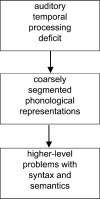Developmental cognitive genetics: how psychology can inform genetics and vice versa
- PMID: 16769616
- PMCID: PMC2409179
- DOI: 10.1080/17470210500489372
Developmental cognitive genetics: how psychology can inform genetics and vice versa
Abstract
Developmental neuropsychology is concerned with uncovering the underlying basis of developmental disorders such as specific language impairment (SLI), developmental dyslexia, and autistic disorder. Twin and family studies indicate that genetic influences play an important part in the aetiology of all of these disorders, yet progress in identifying genes has been slow. One way forward is to cut loose from conventional clinical criteria for diagnosing disorders and to focus instead on measures of underlying cognitive mechanisms. Psychology can inform genetics by clarifying what the key dimensions are for heritable phenotypes. However, it is not a one-way street. By using genetically informative designs, one can gain insights about causal relationships between different cognitive deficits. For instance, it has been suggested that low-level auditory deficits cause phonological problems in SLI. However, a twin study showed that, although both types of deficit occur in SLI, they have quite different origins, with environmental factors more important for auditory deficit, and genes more important for deficient phonological short-term memory. Another study found that morphosyntactic deficits in SLI are also highly heritable, but have different genetic origins from impairments of phonological short-term memory. A genetic perspective shows that a search for the underlying cause of developmental disorders may be misguided, because they are complex and heterogeneous and are associated with multiple risk factors that only cause serious disability when they occur in combination.
Figures






References
-
- Baddeley A., Gathercole S., Papagno C. The phonological loop as a language learning device. Psychological Review. 1998;105:158–173. - PubMed
-
- Bailey A., Parr J. Implications of the broader phenotype for concepts of autism. In: Bock G., Goode J., editors. Autism: Neural basis and treatment possibilities; Novartis Foundation Symposium 251; Chichester, UK: John Wiley; 2003. pp. 26–35. - PubMed
-
- Barnby G., Monaco A. P. Strategies for autism candidate gene analysis. In: Bock G., Goode J., editors. Autism: Neural basis and treatment possibilities; Novartis Foundation Symposium 251; Chichester, UK: John Wiley; 2003. pp. 48–63. - PubMed
-
- Bates E. A. Commentary: Explaining and interpreting deficits in language development across clinical groups: Where do we go from here? Brain and Language. 2004;88:248–253. - PubMed
-
- Bishop D. V. M. Grammatical errors in specific language impairment: Competence or performance limitation? Applied Psycholinguistics. 1994;15:507–549.
MeSH terms
Grants and funding
LinkOut - more resources
Full Text Sources
